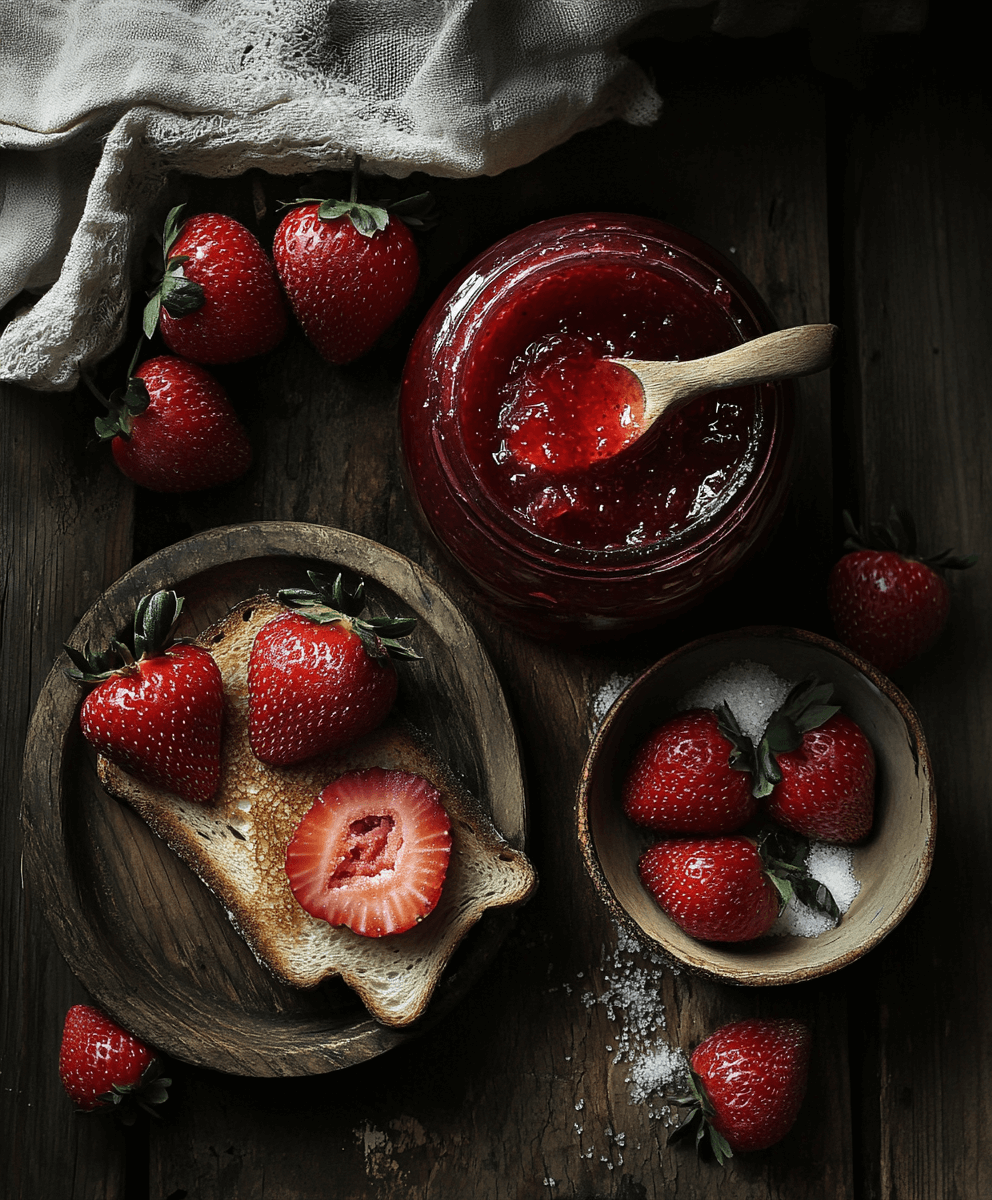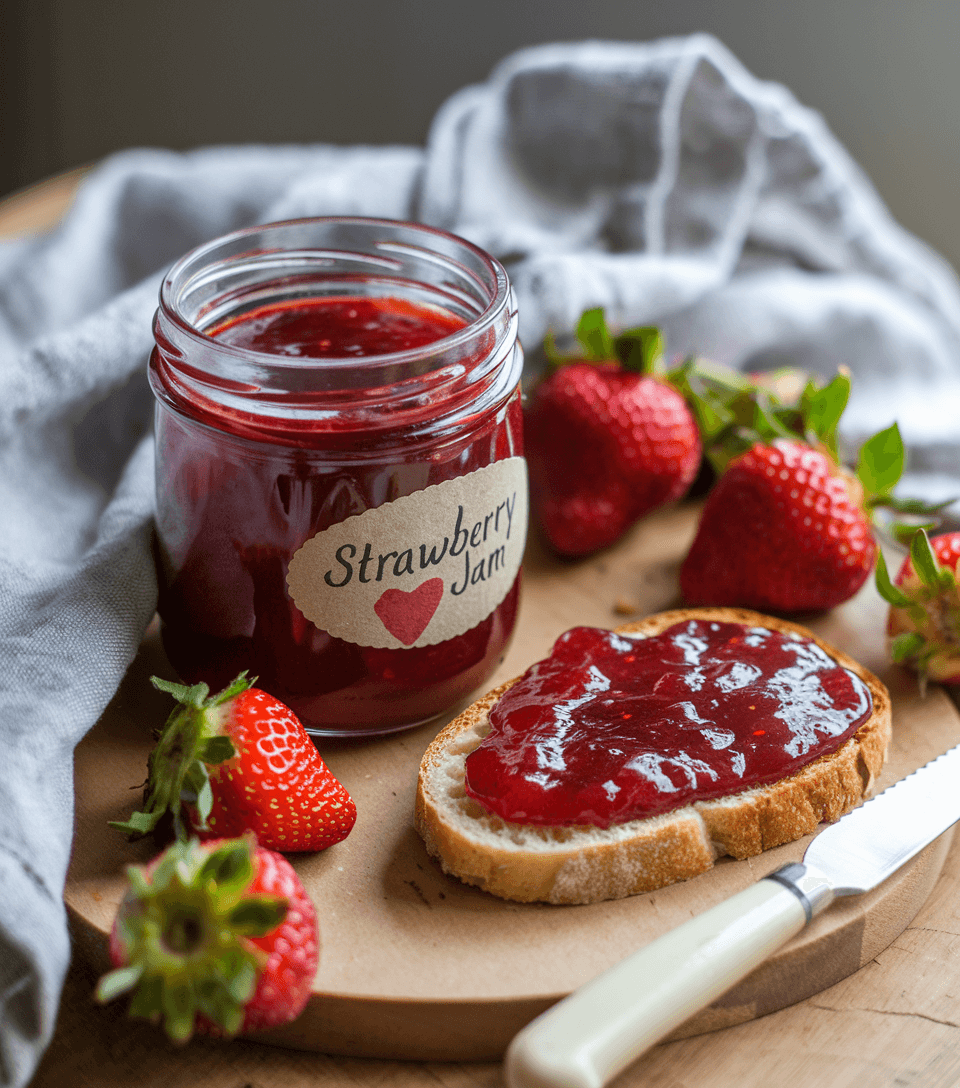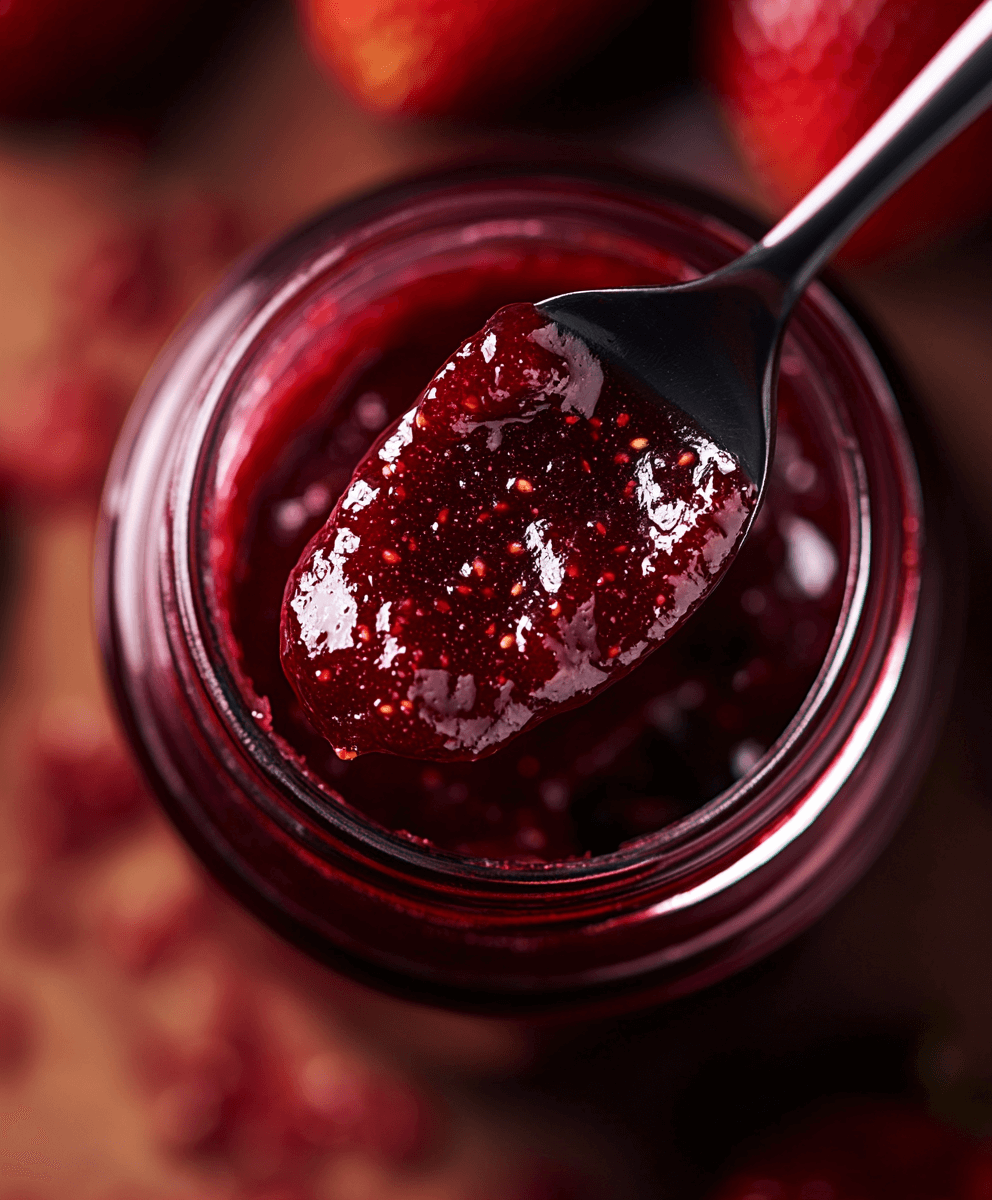Strawberry jam has been a beloved classic for generations, offering the perfect blend of sweetness and tanginess. Whether spread over toast, swirled into yogurt, or used as a filling for pastries, its versatility makes it a staple in many kitchens. There’s nothing quite like the flavor of fresh strawberry jam to add a touch of homemade goodness to your meals.
While store-bought jam is convenient, making strawberry jam at home is surprisingly simple and incredibly rewarding. With just a handful of ingredients and time, you can create a jam bursting with flavor and free of preservatives. Plus, homemade jam allows you to customize the sweetness and experiment with unique variations.
This post will walk you through a step-by-step guide to making strawberry jam explicitly tailored for beginners. From selecting the freshest strawberries to storing your finished product, we have all the tips and tricks you need to succeed. Let’s get started on your homemade strawberry jam journey!
Ingredients and Tools You’ll Need
Gathering the right ingredients and tools before you begin making strawberry jam is essential. Being fully prepared will ensure that the process is seamless and enjoyable.
Fresh Strawberries
The quality of your strawberries is key to making delicious jam. Here are a few suggestions for choosing the most suitable options:
- Choose Ripe Strawberries: For the best flavor, look for bright red, firm, and fully ripened berries. Overripe or mushy strawberries can have a less appealing texture.
- Avoid Berries with Bruises: Damaged or bruised strawberries can affect the overall quality of your jam.
- Seasonal Advantage: Use fresh, in-season strawberries for optimal taste and sweetness. Local farmers’ markets are an excellent source of high-quality berries.
Sugar and Lemon Juice
These two ingredients are essential for both the flavor and preservation of your strawberry jam:
- Sugar: Acts as a natural preservative while enhancing the sweetness of the jam. Modify the quantity according to how sweet you like it.
- Lemon Juice: Adds a hint of tanginess and helps balance the sweetness. It also provides natural acidity, which is crucial for proper preservation and achieving the correct set for your jam.
Optional Pectin
Pectin is a natural thickening agent that helps the jam set correctly. While it’s optional, it can be helpful for beginners:
- When to Use: Adding pectin ensures a consistent texture if you prefer a firmer jam or use strawberries with less natural pectin.
- When to Skip: If you like softer, more spreadable jam or want to keep the recipe simple, you can omit pectin and rely on the natural pectin in the strawberries and lemon juice.
Necessary Tools
Having the right tools will make the jam-making process easier and more efficient. Here’s what you’ll need:
- Canning Jars: Use sterilized jars with tight-fitting lids to store your jam safely.
- Large Pot: A deep pot is essential for cooking the jam without splattering.
- Thermometer: Helps monitor the temperature to ensure the jam reaches the proper setting point (around 220°F or 105°C).
- Ladle and Funnel: For pouring the jam into jars cleanly and efficiently.
- Sterilization Supplies: Tools like tongs and a canning rack are necessary for safely sterilizing and handling jars.

Preparing for Jam Making
Proper preparation is the key to a smooth and successful jam-making process. These steps, from prepping your strawberries to sterilizing your jars, will set you up for delicious results.
Cleaning and Hulling Strawberries
Before you start cooking, it’s essential to clean and prepare your strawberries:
- Wash the Strawberries: Rinse the berries thoroughly under cold running water to remove dirt or debris. Avoid soaking them, as this can cause the strawberries to absorb excess water, diluting the jam.
- Hull the Strawberries: Using a small knife or a hulling tool, remove the green stems and leaves. Slice the tops carefully to preserve as much of the fruit as possible.
- Slice the Strawberries: Depending on your preference, you can leave them whole for chunkier jam or slice them for a smoother texture.
Measuring Ingredients
Getting the correct ratio of strawberries to sugar is crucial for both taste and texture:
- Basic Ratio: A typical ratio is 2 parts strawberries to 1 part sugar (e.g., 4 cups of strawberries to 2 cups of sugar). Adjust based on your desired sweetness level.
- Lemon Juice: Add 1–2 tablespoons of lemon juice per batch to enhance flavor and act as a natural preservative.
- Pectin (if using): Follow the package instructions for the correct amount based on the quantity of fruit.
Sterilizing Jars
Sterilizing jars is essential for safe storage and to prevent spoilage. Here’s how to do it:
- Wash the Jars: Clean the jars and lids with hot, soapy water and rinse thoroughly.
- Boil the Jars: Place them in a large pot of boiling water and let them cook for 10 minutes to sterilize.
- Keep Warm: Leave the jars in the hot water until you’re ready to fill them. Warm jars help prevent cracking when hot jam is added.
- Sterilize Lids Separately: Heat the lids in simmering water, but avoid boiling them, as this can damage the sealing compound.
Setting Up Your Workspace
An organized workspace can make the process more efficient and enjoyable:
- Arrange Your Tools: Lay out your pot, ladle, thermometer, funnel, and sterilized jars within easy reach.
- Prep Ingredients: Have your cleaned and hulled strawberries, sugar, and lemon juice ready.
- Clear the Area: Ensure your countertop or table is clean and spacious to avoid spills and clutter.
- Prepare for Safety: Keep a kitchen towel and oven mitts nearby for handling hot jars and equipment.

Step-by-Step Instructions for Making Strawberry Jam
Now that your strawberries are prepped and your tools are ready, it’s time to start cooking your strawberry jam. Follow these simple steps for a delicious, homemade batch.
Cooking the Strawberries
Softening the strawberries is the first step to achieving the perfect jam consistency.
- Combine Ingredients: Place your cleaned and hulled strawberries into a large pot. If you prefer a smoother jam, mash them slightly with a potato masher or the back of a spoon.
- Heat Gently: Set the pot over medium heat and let the strawberries release their natural juices. Stir occasionally to prevent sticking or burning.
- Simmer the Mixture: Allow the fruit to simmer for 10 minutes until it softens and the juices thicken slightly.
Adding Sugar and Lemon Juice
Sugar and lemon juice are crucial for enhancing flavor and ensuring proper preservation.
- Add Sugar Gradually: Stir in the sugar a little at a time, allowing it to dissolve fully before adding more. This ensures an even texture.
- Pour in Lemon Juice: Add the lemon juice to balance the sweetness and help the jam set.
- Bring to a Boil: Increase the heat and bring the mixture to a rolling boil, stirring constantly to prevent sticking. A rolling boil is necessary for activating the fruit’s natural pectin.
Testing the Consistency
To ensure your jam has reached the perfect consistency, use one of these methods:
- Plate Test: Before starting, place a small plate in the freezer. When the jam thickens, drop a small spoonful onto the cold plate. Allow it to cool for a moment, then lightly press it with your finger. When it creases and maintains its form, it’s prepared.
- Thermometer Examination: Utilize a candy thermometer to measure the temperature. The jam is ready when it reaches 220°F (105°C).
- Visual Cue: If the mixture coats the back of a spoon and drips off slowly, it’s likely ready.
Filling and Sealing Jars
Correctly filling and sealing jars is essential for preserving your strawberry jam.
- Fill the Jars: Using a ladle and funnel, pour the hot jam into the sterilized jars, leaving about 1/4 inch of headspace at the top.
- Remove Air Bubbles: Gently run a knife or skewer around the inside of the jar to release any trapped air bubbles.
- Wipe the Rims: To ensure a proper seal, use a clean, damp cloth to wipe the rims of the jars.
- Seal the Jars: Place the sterilized lids on top and screw the bands on tightly but not overly so.
- Optional Water Bath: For long-term storage, process the jars in a boiling water bath for 10 minutes to ensure a safe, airtight seal.

Storing and Preserving Strawberry Jam
Once your strawberry jam is cooked and sealed, proper storage is essential to keep it fresh and safe. Follow these guidelines for cooling, labeling, and preserving your homemade jam.
Cooling and Labeling Jars
After sealing the jars, it’s essential to let them cool properly before storage:
- Cooling Jars: Place the filled jars on a clean, dry kitchen towel or cooling rack. Let them sit at room temperature for 12 to 24 hours to cool down. To ensure the seals are correctly set, avoid moving or disturbing the jars during this time.
- Check the Seals: After cooling, press the center of each lid. If it does not revert, the jar is sealed properly. If it does pop, the jar does not seal, and the jam should be refrigerated and used promptly.
- Label the Jars: Use labels or a marker to write the type of jam and the date it was made. This helps you keep track of freshness, especially for long-term storage.
Short-Term Storage
For jam that will be consumed quickly, refrigeration is the easiest storage method:
- Refrigeration Timeframe: Homemade jam stored in the fridge can stay fresh for up to 3 weeks.
- Unsealed Jars: If a jar doesn’t seal properly during the canning process, store it in the refrigerator and use it first.
Long-Term Storage
For longer shelf life, water bath canning is a reliable preservation method:
- Process the Jars: Place the sealed jars in a large pot of boiling water, submerging them fully. Boil for 10 minutes (adjusting for altitude if necessary).
- Remove and Cool: Carefully remove the jars with tongs and place them on a towel or cooling rack. Let them cool undisturbed.
- Recheck the Seals: Ensure all jars are properly sealed after cooling. Properly canned and sealed strawberry jam can last up to a year in a cool, dark pantry.
Tips for Proper Storage
To maintain the quality of your strawberry jam, follow these storage best practices:
- Inspect Jars Regularly: Check for any signs of spoilage, such as bulging lids, leaks, or mold. Discard any jars that show these signs.
- Store in a Cool, Dark Place: Keep sealed jars in a pantry or cupboard away from direct sunlight and heat sources.
- Avoid Double Dipping: Always use a clean utensil to prevent contamination when using jam from an open jar.

Tips, Variations, and Common Mistakes
Homemade strawberry jam is already delicious, but you can elevate your jam-making game with a few creative twists and practical tips. Here’s how to explore flavor variations, make small batches, avoid common pitfalls, and use your jam in fun and tasty ways.
Flavor Variations
Add a unique twist to your strawberry jam by experimenting with additional ingredients:
- Vanilla: Stir in a teaspoon of vanilla extract or scrape in a fresh vanilla bean for a warm, sweet undertone.
- Cinnamon: Add a pinch of ground cinnamon during cooking to give your jam a subtle, spiced flavor.
- Balsamic Vinegar: A splash of balsamic vinegar adds a rich, tangy depth that complements the strawberries’ natural sweetness.
- Herbs: Infuse the jam with fresh herbs like basil or thyme for a sophisticated, savory twist.
Pro Tip: Add these ingredients sparingly and taste as you go to ensure the flavors balance well with the strawberries.
Small Batch Jam
If you’re short on time or don’t need an ample supply of jam, small-batch recipes are a great option:
- Adjusting the Recipe: Use half or a quarter of the original strawberries, sugar, and lemon juice quantities.
- Cooking Time: Small batches typically require less cooking time, so monitor the consistency closely to avoid overcooking.
- Storage: Refrigeration is usually sufficient for small batches, as you may not need to can the jam for long-term storage.
Small-batch jam is perfect for beginners or those experimenting with new flavor variations.
Avoiding Common Mistakes
Even experienced jam makers can run into issues. Here’s how to avoid the most common mistakes:
- Overcooking: Overcooking can cause your jam to become too thick and lose its fresh flavor. Always test the consistency early and often.
- Undercooking: If your jam is too runny, it may need more time on the stove. Use the plate test or a thermometer to check readiness.
- Skipping Sterilization: Not sterilizing jars properly can lead to contamination and spoilage. Always clean and sterilize your jars before filling them.
- Ignoring Air Bubbles: Trapped air bubbles can affect the seal of your jars. Use a knife or skewer to release them before sealing.
Using Your Strawberry Jam
Homemade strawberry jam is incredibly versatile. Here are some ideas to enjoy it beyond the usual toast:
- Spread on Toast: A classic breakfast option, especially with butter or cream cheese.
- Mix into Yogurt: Stir a spoonful into plain or Greek yogurt for a naturally sweet and fruity snack.
- Use as a Glaze: Brush it over baked goods like scones, cakes, or pastries for a shiny, sweet finish.
- Pair with Cheese: Serve strawberry jam alongside soft cheeses like brie or goat cheese for an elegant appetizer.
- In Beverages: Mix a dollop into sparkling water or lemonade for a refreshing strawberry-flavored drink.

Conclusion
Making homemade strawberry jam is a rewarding and straightforward process that allows you to create a sweet, flavorful spread tailored to your preferences. The possibilities are endless, from selecting fresh strawberries to customizing flavors and experimenting with new variations. The result is a jar of jam that’s delicious and free of unnecessary preservatives and additives.
This guide has inspired you to try making strawberry jam at home. Whether you stick to the classic recipe or add your creative twists, there’s no better way to enjoy the vibrant taste of fresh strawberries year-round.
Have you tried this recipe, or have your tips and tricks for making strawberry jam? We’d love to hear from you! Share your results, favorite variations, or jam-making stories in the comments below. Don’t forget to post your creations on social media and tag us—we can’t wait to see what you’ve made. Happy jam-making!

Homemade Strawberry Jam
Equipment
- Large pot
- Canning jars with lids and bands
- Ladle and funnel
- Potato masher Optional
- Sterilization tools: large pot, tongs, and canning rack
Ingredients
For the Jam:
- 4 cups Fresh strawberries (about 2 pounds), hulled and sliced
- 2 cups Granulated sugar (adjust to taste)
- 1-2 tbsp Lemon juice (freshly squeezed)
- 1 Package Pectin (for a firmer set) optional
Instructions
Prep the Strawberries:
- Wash the strawberries under cold running water and pat them dry.
- Hull and slice the strawberries. Leave them whole for a chunky texture or mash them for a smoother jam.
Measure Ingredients:
- Combine the strawberries with sugar and lemon juice in a large pot. Adjust the sugar based on your desired sweetness level.
Cook the Jam:
- Heat the pot over medium heat, stirring occasionally as the strawberries release their juices.
- Bring the mixture to a gentle boil, then increase the heat to reach a rolling boil, stirring constantly.
- If using pectin, add it according to the package instructions during this step.
Test the Consistency:
- Use the plate test: Drop a small amount of jam onto a chilled plate. Let it cool for a minute, then press it with your finger. If it wrinkles and holds its shape, it’s ready.
- Use a thermometer to ensure the jam reaches 220°F (105°C), the ideal setting point.
Sterilize the Jars:
- Boil the jars and lids in a large pot for 10 minutes to sterilize them. Keep them warm until ready to use.
Fill the Jars:
- Using a ladle and funnel, pour the hot jam into the sterilized jars, leaving about ¼ inch of headspace.
- Run a knife or skewer around the inside of the jars to release any air bubbles.
- Wipe the rims clean and seal with the sterilized lids and bands.
Process the Jars (Optional for Long-Term Storage):
- Submerge the filled jars in a boiling water bath for 10 minutes.
- Remove and let them cool undisturbed for 12–24 hours.
Check the Seal:
- Once cooled, press the center of each lid. If it doesn’t pop back, the jar is sealed correctly. If it pops, store the jam in the refrigerator and consume it first.






